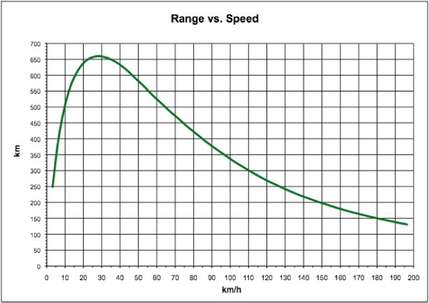Driving conditions, as well as driver skills and habits, have a large influence on energy use. Tesla Motors have detailed some of these relationships in several of their blogs. The nominal EPA range of the 2009 Tesla Roadster with the original battery was 390 km (245m). That this range was not fiction was demonstrated 2009 and again 2010 in a rally in Southern France. Carefully driven on mountainous backroads the range to empty would have been around 450 km. The roadster shown in April 09 to interested parties in Zurich was driven about 320 km without recharging from Munich to Zurich and had some reserves left. Another Tesla Roadster was then driven from Zurich to St. Moritz, across the Julier Pass, with snow tires and some heating. Only 210 km, but climbing also from 400m to 2300m. Considering that this is a close to 3 hours drive with a fair stretch on a winding mountain pass road, not everybody would (and should) drive any further without a solid break. At lower speeds the stated ranges can become also larger than EPA standard ranges as demonstrated in Australia where a record 501 km was driven on a single charge. These relationships are partly very different for conventional cars. Their mileage tends to worsen notably at speeds below about 80 km/h and suffer at low temperatures on short stretches. Most estimates of potential fuel substitution ignore such effects and overestimate consequently the call on additional electricity.
Clearly these ranges cannot satisfy as yet regular motorway speed long distance drivers, but show how close we are to widely usable electric vehicles: A lot closer than many still believe.† Tesla builds highly efficient drive trains - by no means an easy task. The technical achievement is respectable. Tesla Motors has won a leading position in this technology. Of course technology does not stand still. Motors, batteries and control electronics, as well as the science surrounding electrochemical cells evolve relatively fast. Also Tesla's new Model S and now also the Model 3 demonstrate remarkable progress.
Tesla builds highly efficient drive trains - by no means an easy task. The technical achievement is respectable. Tesla Motors has won a leading position in this technology. Of course technology does not stand still. Motors, batteries and control electronics, as well as the science surrounding electrochemical cells evolve relatively fast. Also Tesla's new Model S and now also the Model 3 demonstrate remarkable progress.
I outlined my views on future trends here. Of course range on a single charge is not the only issue. It is also important to know where and how fast a car can recharge.
The original model S achieves usually more than 400 Km under ordinary mixed driving conditions in Switzerland and its latest version (P100D)†surpasses that again with around 500Km (613 Km, NEDC cycle test).†